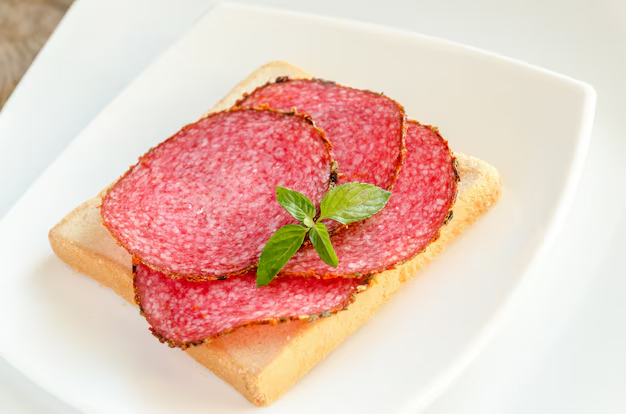Genoa salami is a type of Italian dry salami that has gained popularity worldwide for its rich flavors and smooth texture. Whether you’re a food enthusiast or simply someone who enjoys a good sandwich or charcuterie board, this cured meat brings depth to any meal. But what makes Genoa salami so special? Let’s delve into its history, characteristics, and the best ways to incorporate it into your meals.
What is Genoa Salami?
Genoa salami is a finely textured, dry-cured sausage made from a mixture of pork and beef. This blend of meats gives it a unique balance of flavors that range from savory to slightly tangy. It is typically seasoned with garlic, wine, and spices like black pepper, and sometimes even fennel seeds, which contribute to its aromatic taste.
This salami gets its name from Genoa, a port city in Italy, though it is made and enjoyed throughout the country and the world. The Italian tradition of salami-making dates back centuries, with each region crafting its own variations of this beloved charcuterie.
Key Characteristics of Genoa Salami
Several characteristics define Genoa salami, making it easily distinguishable from other types of salami. These include:
- Meat Composition: Genoa salami is primarily made from pork and beef, offering a more balanced, flavorful taste compared to other salamis that may use only one type of meat.
- Texture: The salami has a smooth, tender texture, with fat evenly distributed throughout the sausage. This is partly due to the high fat content, which gives the salami its distinctive mouthfeel.
- Flavor: Genoa salami is seasoned with garlic, black pepper, and wine. Its flavor is bold but not overpowering, with the wine adding a subtle tanginess.
- Appearance: It features a deep, reddish color with visible bits of fat marbling. The sausage is typically wrapped in a natural casing, which gives it its signature look.
History and Origin of Genoa Salami
The origin of Genoa salami can be traced back to the region of Genoa, Italy. The process of curing meats in this region dates back to Roman times, with local butchers refining their recipes over generations. The unique climate and availability of both pork and beef in the area helped establish Genoa as a key location for salami production.
Over the centuries, Genoa salami spread throughout Italy and eventually to other parts of Europe and North America. Immigrants brought their salami-making traditions with them, making it a staple in many households worldwide. Its popularity grew due to its long shelf life and ability to be preserved without refrigeration, making it an ideal travel food.
How is Genoa Salami Made?
Genoa salami follows a traditional production process that combines both science and art. Here’s how it’s made:
- Meat Selection: High-quality cuts of pork and beef are chosen for their texture and fat content. The ratio of meat to fat is essential to create the perfect Genoa salami.
- Grinding and Seasoning: The meat is ground to a fine texture, and seasonings like garlic, black pepper, and wine are added. Some variations may also include fennel seeds or other spices, giving the salami its unique flavor.
- Stuffing and Casing: The seasoned meat mixture is then stuffed into natural casings, traditionally made from the intestines of pigs. The casing helps to hold the salami’s shape while it cures.
- Curing Process: Genoa salami is hung in a cool, controlled environment to cure for several weeks. The curing process allows the flavors to develop and the meat to dry out, which is essential for its long shelf life.
- Aging: The aging period typically lasts from several weeks to a few months. During this time, the salami becomes firmer and more flavorful.
How to Enjoy Genoa Salami
Genoa salami is incredibly versatile and can be enjoyed in a variety of ways. Here are a few ideas:
1. On a Sandwich or Sub
Genoa salami makes for an excellent sandwich filler. Pair it with fresh bread, such as a baguette or ciabatta, and add cheese, lettuce, and your favorite condiments. It’s a simple yet satisfying meal.
2. Charcuterie Board
Include Genoa salami as part of your charcuterie board. Its smooth texture and bold flavor pair well with cheeses like brie, provolone, and gouda, as well as a variety of crackers, olives, and fruits.
3. Pizza Topping
Genoa salami can add an interesting twist to your pizza. Try it as a topping alongside other ingredients like peppers, onions, and mushrooms. The rich flavor of the salami complements the tangy tomato sauce and melted cheese.
4. In Pasta Dishes
For a hearty pasta dish, add Genoa salami to the sauce. Its savory flavor enhances tomato-based sauces and can also be added to creamy dishes like Alfredo for an extra touch of richness.
5. Salads
Genoa salami can be chopped into small pieces and added to salads. Its robust flavor contrasts nicely with the freshness of leafy greens, tomatoes, and cucumbers.
Genoa Salami vs. Other Types of Salami
While Genoa salami is widely enjoyed, it’s just one of many types of salami available. Here’s a quick comparison of Genoa salami with other popular varieties:
| Feature | Genoa Salami | Pepperoni | Soppressata |
| Main Meat | Pork and beef | Primarily pork | Pork, sometimes with a blend of beef |
| Texture | Smooth and tender | Firm and slightly chewy | Coarse and firm |
| Fat Content | High (provides rich flavor) | Moderate | High (provides flavor and texture) |
| Seasoning | Garlic, black pepper, wine, fennel | Paprika, chili flakes, garlic, fennel | Black pepper, garlic, red wine |
| Curing Process | Air-dried and aged | Dry-cured, often smoked | Air-dried and aged |
| Flavor Profile | Savory, tangy, slightly spicy | Smoky, spicy, tangy | Savory, spicy, sometimes slightly sweet |
| Common Uses | Sandwiches, charcuterie, pasta | Pizzas, sandwiches, snacking | Charcuterie, sandwiches, antipasto |
As seen in the table above, each type of salami has distinct characteristics that make them suitable for different dishes. Genoa salami, with its smooth texture and rich flavor, stands out as a more versatile option, especially for pairing with a variety of ingredients.
Health Considerations
While Genoa salami is delicious, it’s essential to consider the health implications of consuming cured meats. Here are a few points to keep in mind:
- Caloric Content: Genoa salami is high in calories, primarily due to its fat content. Moderation is key if you are mindful of your calorie intake.
- Sodium: Like many cured meats, Genoa salami is high in sodium, which can contribute to high blood pressure if consumed excessively.
- Preservatives: Some commercially produced salamis may contain nitrates or nitrites, which are used as preservatives. While these chemicals are generally regarded as safe in small amounts, it’s always best to choose products made with fewer artificial additives.
Nutritional Breakdown (Per 1 oz / 28 g)
| Nutrient | Amount |
| Calories | 100 kcal |
| Total Fat | 8 g |
| Saturated Fat | 2.5 g |
| Cholesterol | 20 mg |
| Sodium | 350 mg |
| Total Carbohydrates | 0 g |
| Protein | 7 g |
Conclusion
Genoa salami is more than just a tasty addition to your charcuterie board or sandwich—it’s a piece of culinary history. Its rich blend of pork and beef, coupled with a careful mix of spices and curing techniques, creates a flavor profile that stands out from other cured meats. Whether you’re enjoying it on a pizza, in a salad, or simply on its own, Genoa salami remains a timeless delicacy that continues to be beloved worldwide. By understanding its origins, preparation, and uses, you can better appreciate this flavorful treat and incorporate it into your meals with ease.
As we continue to embrace culinary traditions and innovations, Genoa salami remains an essential part of many cuisines. Whether you’re a seasoned salami lover or a newcomer to the world of cured meats, there’s no denying the delicious appeal of this classic Italian sausage.







